Barnacles feed on tiny organisms in the surrounding water. They use their feet to catch food and filter out organic matter from the water.
Barnacles have been known to attach themselves to whales, turtles, and other large ocean animals. This is a mutually beneficial relationship for the barnacle and its host as it provides protection from predators and a supplementary food source for the host.
In this article, I will provide more detail on what these small organisms do and why they are so important in the marine environment.
Barnacles Definition: What Are Barnacles?
Barnacles are special critters. They belong to a group called Cirripedia, which is part of a bigger group named Crustacea. So, are barnacles crustaceans? Yes, they are small crustaceans, closely related to shrimps, crabs, and lobsters. These sea critters live in a lot of places like rocky shores, sandy beaches, tidal pools, and even on whales and turtles!
What makes barnacles special is the hard shell of calcium covering them up. These little guys make a series of hard plates from calcium to build a cone-shaped shield around them. The last four plates make a ‘door’ that the barnacle can open or close based on the tide. This cool feature is a must-have for them. It helps control the water and food they take in and keeps predators out.
When they are young, called barnacle larvae, they can swim freely and stick to all sorts of places. After finding the right spot, they start to make their hard plates and build their cone-shaped home. Their home can get really big, from just a few millimeters to over 20 cm across!
Fun fact is, barnacles eat by filtering water. They use special legs called cirri to catch tiny creatures like plankton. In addition to their food habits, they are hermaphrodites. It means each one has both male and female parts. This lets them make babies independently, but mixing genes with others is more usual.
Types of Barnacles: Quick Chart
Barnacles have 3 broad types. Here is a table for you.
| Types of Barnacle | Interesting Fact |
| Goose Barnacle (Thoracica) | Not actually related to geese; they were once thought to be the origin of geese. |
| Acorn Barnacle (Balanus glandula) | They cement themselves head-first to a surface, revealing only their legs to feed. |
| Sacculina | Parasitic barnacles that inject their cells into host crustaceans, ultimately controlling them. |
What Do Barnacles Do?
As sessile sea creatures, barnacles do both good and bad in the ocean. They act like filters in the sea. They use “suspension feeding” to eat tiny bits like plankton. This helps clean the water for other sea life.
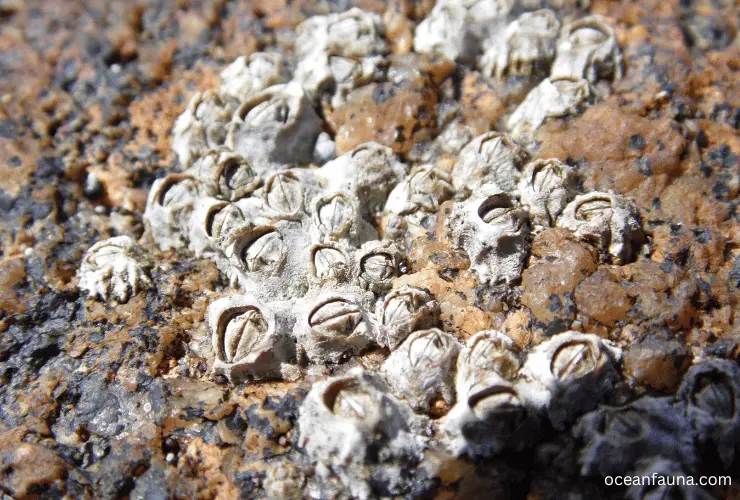
Since barnacles are stationary, they offer a cozy spot for others. Barnacles stay in one place. This makes them a home for algae and tiny critters that need something to cling to.
However, not all barnacles are the same, though. Some barnacles, like Sacculina carcini (“Rhizocephala” group), can harm other sea critters. For example, they can be parasitic and infect other crustaceans like crabs. But some barnacles help larger sea animals like turtles and whales. They clean the animals’ shells and get a safe home in return.
In addition, barnacles can tell us about water quality. If you see a lot or just a few, that says something about how healthy the ocean is.
But we’ve got to be careful. Sadly, barnacles are vulnerable to pollution, especially plastic microparticles. When ingested, these particles can disrupt the barnacles’ feeding method, causing them to starve. This affects the barnacles themselves and has a ripple effect on other organisms within the food chain.
So, keeping these sea critters safe for a clean and healthy ocean is key. How can we do that? Well, cut down on plastic waste and toss it the right way. Let’s also stop more pollution from going into the sea.
What Do Barnacles Do Once They Attach?
Barnacles latch onto things like rocks, boats, ships, and marine creatures like whales, turtles, and crustaceans. Then they start oozing a special glue to stick tight. This special glue is called “barnacle cement.” It’s made of stuff like proteins and fats. This mix helps them stick well to hard things, even to animals.
After a barnacle sticks to a spot, it keeps oozing glue as it gets bigger over time. The glue that barnacles make is super strong. It can deal with hard stuff like water currents, predators, and bad weather.
Guess what? Barnacle glue also helps them stay clean. Stuff like bacteria and algae can’t stick to them, so they can feed and grow with no fuss. So, this glue keeps barnacles stuck and wards off critters they don’t want around.
But, when it’s about parasitic barnacles, they can feed on their host. For example, Sacculina feeds on crabs and also impacts their reproduction.
Why Do Barnacles Attach to Animals?
There are several reasons why barnacles attach to animals, which can be grouped into four broad categories: substrate availability, feeding opportunities, passive transport, and defensive advantage.
Substrate Availability
One reason why barnacles attach to animals is the availability of suitable substrates for settlement and growth. These critters are filter-feeders and need a hard surface to thrive. This helps them catch food in moving water.
Sure, rocks and shells exist, but sometimes they’re not plentiful enough for barnacles to flourish. Marine creatures give them another option—a moving but sturdy surface. This way, barnacles get a steady food supply and stay safe from predators.
Feeding Opportunities
Another reason barnacles attach to animals is the abundance and diversity of food sources associated with them. Many animals are both barnacles’ hosts and sea hunters. They go after small fish and other sea critters. This hunting stirs up the water and moves food particles around.
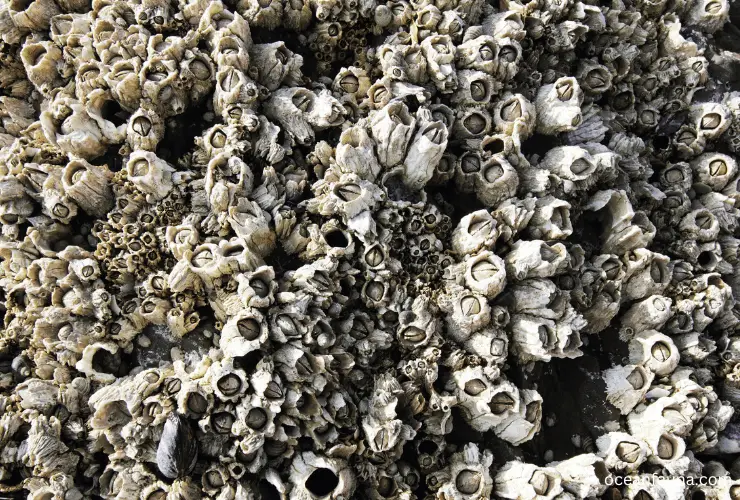
Barnacles that attach to the surface of the host can intercept some of these particles and benefit from the feeding activity of the host.
Take sea turtles as an example. They look for food in grass beds and coral reefs. Barnacles latch onto their shells and fins. These barnacles can eat different types of food and adapt to changes in water flow.
Passive Transport
A third reason why barnacles attach to animals is the opportunity for passive transport to new habitats or distant places. Barnacles can hitch a ride on animals. This way, they use the animal’s skills to swim or fly. It helps them get to places they can’t reach on their own.
Barnacles can attach to more than one host while they’re still young. This boosts their chances of finding the right place to live. Plus, it keeps them from fighting with their own kind for room and food.
Some hosts are great travelers, moving from place to place. This helps barnacles face new things like shifts in heat, salt levels, and even sunlight. These changes can make barnacles stronger and help them grow in new ways.
Defensive Advantage
A fourth reason is a defensive advantage that the host can provide against predators or competitors. Barnacles face many risks when they live in open spots. Waves can hit them, other sea life can scrape them, and fish and crabs can eat them.
Barnacles can cut risks by sticking to big, moving animals. These hosts give them a shield, blend them in, or even add a chemical guard.
Take humpback whales. They feed close to the water’s top and get barnacles on their fins. This can mix up or even scare off their hunters like killer whales.
Crabs are another good example. They live in rocky nooks and can carry barnacles on their shells. This puts off birds and other hunters that can’t get to the barnacles.
How Do Barnacles Stick to Animals?
So you’re curious about how barnacles stick to things, huh? They can latch onto many places, like animals, rocks, and even things we humans make. The way they stick is key to staying alive. They use a super-sticky substance that holds them tight to where they want to be.
Barnacles make a super-strong glue that sticks well, even in rough seas. This glue has a mix of proteins, fats, and sugars. It comes from what’s called a cement gland.
When it’s time to stick, the young barnacle uses a special leg, the cypris leg. It then leans its head on the surface and oozes glue from its cement gland.
The barnacle’s glue loves water, making the bond even stronger. It’s so tough that even strong currents and big waves can’t pull it off.
After sticking, the barnacle grows a hard shell for safety. Over time, it grips the surface so tight that it’s hard to remove, even if it’s dead.
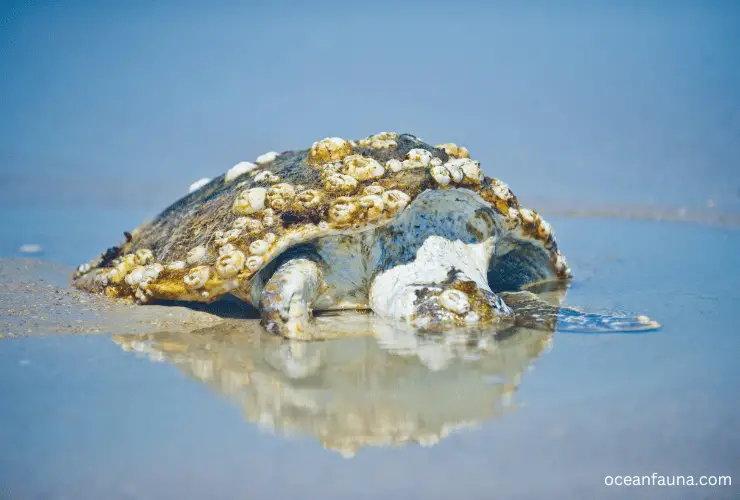
What Do Barnacles Do to Turtles?
So, what barnacles do to turtles? Are barnacles bad for turtles? Barnacles are tiny sea creatures that attach themselves to the shells or skin of sea turtles. Most barnacles are harmless, but some can actually burrow into the turtle’s skin. This can cause discomfort and even infections. So, in some cases, barnacles can be bad for turtles.
In addition to physical discomfort, barnacles make turtles more likely to get sick. A turtle with a bunch of barnacles clinging to its shell might not be the picture of health.
Barnacles can create surface drag and mess up a turtle’s streamlined shape. This makes swimming more difficult for them. So, if you find yourself in the position of removing barnacles from turtles, tread carefully. Especially be gentle if the turtle’s shell seems weak or damaged.
What Do Barnacles Do to Whales?
Are barnacles harmful to whales? Barnacles stick to the skin of whales but don’t harm them. They simply hitch a ride and live on the whale’s skin. This bond is called “Whales and Barnacles Commensalism,” where the barnacle gains and the whale isn’t harmed.
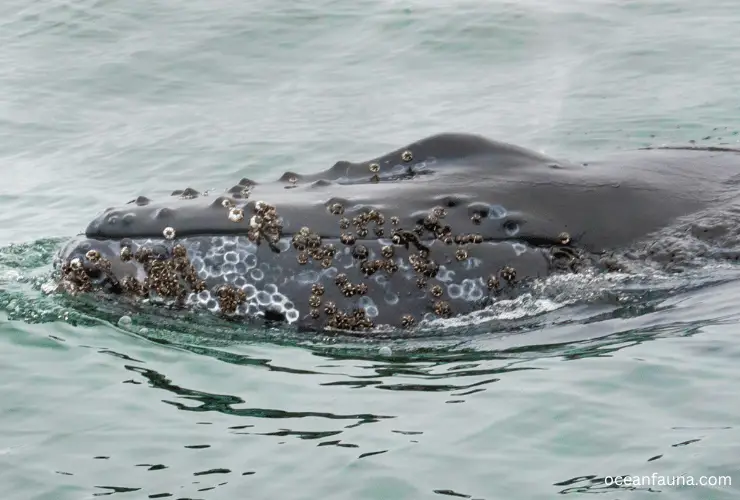
For barnacles, sticking to a whale means they get a stable home. It also lets them feed on tiny sea life as the whale swims through food-rich waters. The gray whale is a top pick for barnacles. It swims slowly, helping barnacles feed more easily. The whale simply gives barnacles a home and doesn’t seem to hurt or help the whale much.
It’s cool to think how the barnacle-whale bond can play a big role in ocean life. And this isn’t just about whales and barnacles; many animals have these give-and-take ties. Still, seeing a tiny barnacle on a huge whale reminds us how all of nature is linked.
What Do Barnacles Do to Ships?
Barnacles are small critters that stick to the bottom of ships and boats. This can cause both money and eco troubles.
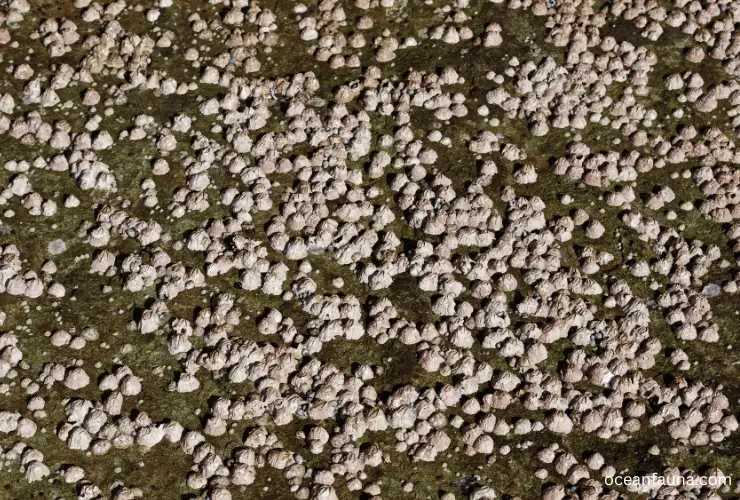
Not just that, barnacles can rust the ship, too. This can make the ship weak over time. Barnacles are a snack for some sea life. This can draw big fish like whales and sharks close, and they might harm the ship.
As barnacles grow, they group up. These groups make the ship’s bottom rough, slowing it down and using more fuel. A ship full of barnacles can get 60% heavier and slower. This can make the ship use up to 40% more fuel.
Cleaning off barnacles often is key to keeping a ship’s bottom in good shape. You can use tools like scrapers or power washers to get them off. These methods do take time, sweat, and can harm the sea.
That’s why some folks like to use special paints to keep barnacles away. These paints have stuff in them that barnacles don’t like. But watch out, some barnacles can now beat some of these special paints.
So, what do barnacles do to ships? They slow them down, hike up fuel bills, and even put the ship at risk. But you’ve got options to deal with these sticky stowaways!
What are the Good Things with Barnacles?
Barnacles do some neat stuff for both the sea and for us folks. One good thing about barnacles is that they clean the sea. They eat tiny sea stuff like plankton. This helps clean the water for other sea life, which is great for the ocean’s health.
Plus, lots of birds and fish love to eat barnacles. So, they’re not only cleaning the water but also a tasty snack for other animals. This helps keep the food chain going strong.
Now, it’s not just sea life that gets a boost from barnacles. Besides being seafood, some people eat barnacles. They’re tasty and packed with protein. In some places, they’re a real treat to have on your plate.
But that’s not all! Doctors and labs are checking out barnacles, too. They might have stuff in them that can help fight sickness and even cancer. Who knew, right?
Last but not least, barnacles are cool because they can stick to almost anything. They’ve been around for ages, and scientists love studying how they stick to things. This helps us learn more about how stuff can stick together, which is good for making all sorts of things.
What are the Problems with Barnacles?
Even though they help in some ways, barnacles can also be a real pain for some. Like I said, barnacles sticking to ships make them slow down. That means more fuel gets used up.
Sometimes, barnacles can also mess up docks and seawalls. If a bunch of them latch onto these places, they can make holes in the wood or concrete.
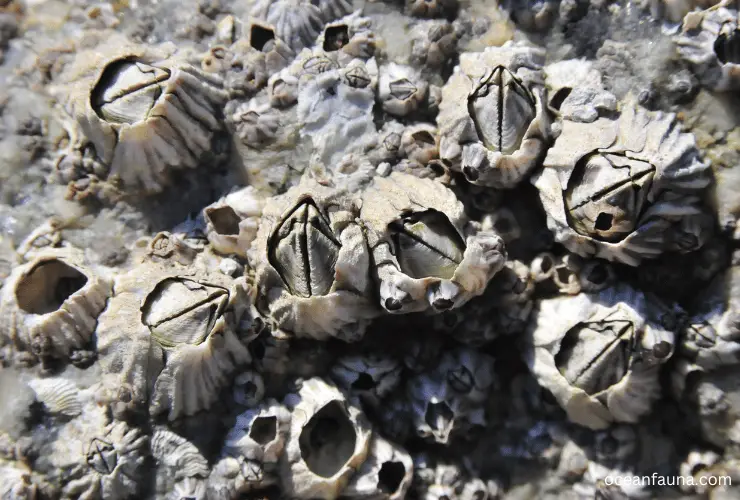
But wait, there’s more! Barnacles can clog up water pipes, and that can make engines overheat. Yep, if you rely on water from the sea for your engine, watch out for barnacles.
And let’s not forget about the other sea critters. Some barnacles from far away places hitch a ride on ships. Once they get here, they can push out our local barnacles and mess up the sea life balance.
Moreover, parasitic barnacles like Sacculina can cause harm to marine animals. Also, if sea turtles get too many barnacles on them, they can get sick or even die. These extra loads make it hard for them to swim and eat.
Barnacles can also harm coral reefs. They block them and make them more likely to get sick and die. So, yeah, barnacles may do some good, but they’ve got a dark side too. Keep an eye out!
What Do Barnacles Hate?
So you wanna know what barnacles can’t stand? Copper is their kryptonite. People have used it for ages to keep barnacles off boats and sea stuff.
Why does copper work? Simple. When copper comes into contact with seawater, it triggers a chemical reaction. This produces copper particles that barnacles find unpleasant, preventing them from attaching to surfaces.
You find barnacles often in the sea, sticking to things they shouldn’t. They’re bad news for boats because they slow them down and waste fuel. That means you pay more for upkeep and fuel, not to mention the harm to Mother Nature.
Copper works well to keep barnacles away. Tests show that copper paints really stop barnacles from hitching a ride.
These special paints mix copper stuff like copper oxide with other things. Then you slap it on the boat. And guess what happens? When the paint hits the water, it lets out copper bits that barnacles can’t stand. So, they stay away.
Are Barnacles Harmful to Humans?
Do barnacles hurt humans? You might know barnacles as tough on boats and ships. But they are not harmful to humans.
People often ask, “Are barnacles edible?” Yes, barnacles are edible. You can eat them if they’re cooked? Many cultures have even made them a part of their diet.
So, how do you eat barnacles? You can eat the meat inside, raw or cooked, once you get it out of the shell.
But watch out, not all barnacles are good to eat. Some can make you sick or worse. So, you’ve got to know your barnacles before digging in. Also, make sure to only eat barnacles from clean water, okay? You don’t want any nasty surprises.
FAQs
What do barnacles eat?
Barnacles mainly eat microscopic organisms like plankton. It helps keep the ocean clean and healthy for other sea life. However, parasitic barnacles like Sacculina feed off other marine animals (crabs).
Can barnacles harm a ship?
Yes, barnacles can harm ships in multiple ways. They slow down the vessel and increase fuel consumption. The barnacles’ weight can also weaken the ship over time, making it vulnerable to damage.
What do baby barnacles look like?
Baby barnacles, specifically in their final larval stage known as the cypris, look somewhat like tiny clams or ostracods. They have two large shells, also called valves, that are hinged together at the top. The bottom side of these shells is open. Before reaching this cypris stage, the barnacle goes through six earlier stages as a nauplius larva.
Conclusion
Hopefully, you have a detailed idea of what is a barnacle and what it does in the marine environment. It has both the good and bad sides.
Some barnacles can become parasitic and cause harm to marine structures and organisms, whereas. On the other hand, other barnacles are non-parasitic. Humans can consume them if properly identified and harvested from clean waters.
If you have any further queries regarding them, let me know. Happy Learning!

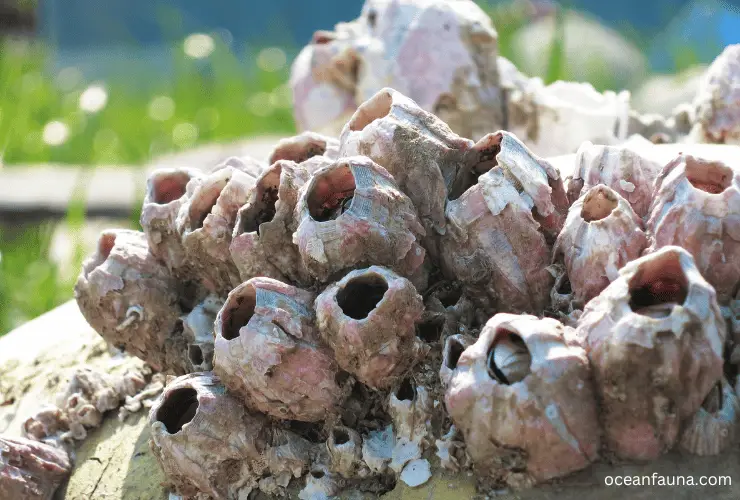
2 thoughts on “Barnacles Definition: What Do Barnacles Do?”